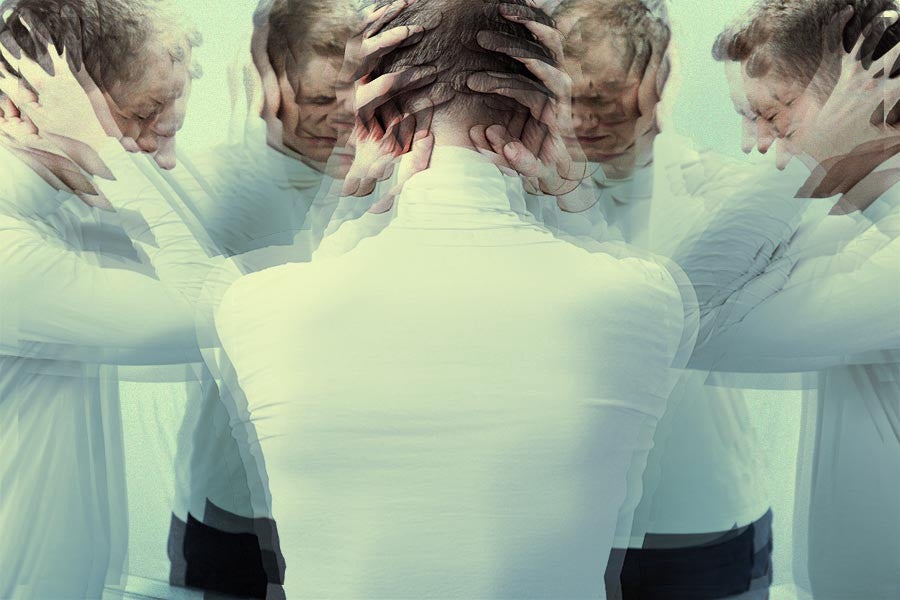Browse any studies about anxiety and gender and you’ll come away with one consistent takeaway: Women are some anxious motherfuckers. They have a clear monopoly on anxiety disorders at nearly twice the rate of men, according to a review of 48 previous studies on the issue. A new study using brain imaging also found that women’s brains are more active than men’s in the limbic region, which could point to a greater biological susceptibility to anxiety.
But such studies should always be viewed with the understanding that anxiety differences in the brain, like sex differences, are much more complicated than simple biology. The factors that create an anxiety gender gap involve major cultural discrepancies in how we condition men and women to deal with their worries.
In 2011, Taylor Clark explored these differences in Nerve: Poise Under Pressure, Serenity Under Stress, and the Brave New Science of Fear and Cool. In a companion piece at Slate, he breaks down our perceptions about anxiety being a female problem: Women are not only said to be twice as prone to anxiety as men, he writes, but they’re diagnosed at twice the rate, too. In surveys, women openly admit to far greater concerns than men do, and the result is that we conclude women are simply more nervous than men — not cut out for the stresses of life. He calls hard bullshit on the idea:
When it comes to our preconceived notions about women and anxiety, women are unfairly being dragged through the mud. While women are indeed more fretful than men on average right now, this difference is mostly the result of a cultural setup — one in which major social and parenting biases lead to girls becoming needlessly nervous adults. In reality, the idea that women are “naturally” twice as anxious as men is nothing more than a pernicious illusion.
This pernicious illusion is not based on nothing, though. There are studies, at least on rat brains, that indicate female rats are more affected than male rats by a stress hormone called corticotrophin. Another study (on rats) found that testosterone actually protects male rats from feeling as anxious.
So human women could be both more susceptible and less protected from worry—but these factors aren’t anywhere near as influential and observable as the fact that culturally, we flood women with a tidal wave of conditioning that fosters a nervous disposition, associates it with femininity itself, and thwarts the very coping skills that would help them “shake it off,” as we counsel men to do. Clark:
If women really were fated to be significantly more anxious than men, we would expect them to start showing this nervousness at a very young age, right? Yet precisely the opposite is true: According to the UCLA anxiety expert Michelle Craske, in the first few months of infants’ lives, it’s boys who show greater emotional neediness. While girls become slightly more prone to negative feelings than boys at two years (which, coincidentally, is the age at which kids begin learning gender roles), research has shown that up until age 11, girls and boys are equally likely to develop an anxiety disorder. By age 15, however, girls are six times more likely to have one than boys are.
Naturally, if there’s anyone to blame here, it’s our parents. Craske told Clark that the real kicker is that we simply treat boys and girls differently when they get a hot case of the feels. “From a socialization angle, there’s quite a lot of evidence that little girls who exhibit shyness or anxiety are reinforced for it, whereas little boys who exhibit that behavior might even be punished for it,” she told him.
Clark calls it the “skinned-knee effect” in his book, Nerve, and we’ve all experienced it ourselves, or likely even inadvertently perpetuated it. When a boy gets hurt and cries, we tell him to suck it up, or get over it. When a girl cries, she’s nurtured, kissed and indulged. This message is simple, but powerful: “If little Olivia shows fear, she gets a hug; if little Oliver shows fear, he gets urged to overcome it,” Clark writes.
But that’s not all! From there, Clark notes, women are bombarded with far greater societal messages that induce a low-simmering fret—like that they’re imperfect physically—adding another layer to the socialized worry they inherit. To say nothing of the fact that if women are less empowered than men in the world, and live longer to boot, they have good reason to feel a little bit more worrisome. The net result: After all this conditioning that encourages women to worry, we add insult to injury when we turn around and declare them naturally more emotional. Clark continues:
A recent, highly revealing study showed that even in situations in which male and female subjects experience the same level of an emotion, women are consistently seen — and even see themselves — as being “more emotional” than men. It shouldn’t be too surprising, then, that this bias holds for anxiety as well; we buy into the fretful-women stereotypes far too often. Another report, for example, found significant differences in the way doctors respond to patients who report common stress symptoms like chest pain: Whereas men get full cardiac workups, women are more often told that they’re just stressed or anxious, and that their symptoms are in their heads.
So about those men… Anxiety has similar symptoms in both sexes — being anxious in and of itself isn’t a gendered experience. It could mean panic attacks, dizziness, heart palpitations, worry, fretting, nausea, chest pain or dread. Women may specifically experience different results from the lowered serotonin levels anxiety can cause — they become less impulsive, whereas men may become more impulsive.
But where men have their own monopoly on anxiety is when it comes to the accompanying shame they feel when they experience it. “If you’re male and have been socialized to be active and controlling, anxiety is (perceived) as a sign of weakness,” anxiety expert Neil Rector told an anxiety clinic in British Columbia, AnxietyBC. “Men with anxiety berate themselves, saying, ‘I’m vulnerable, I’m failing.’ Their embarrassment prevents them from reaching out for help. This means that by the time they do get a consult, their condition is more severe than that seen in women.”
That shame and embarrassment means men are less likely to seek any treatment at all, and instead numb the discomfort on their own by self-medicating with booze, weed, painkillers or escaping into work. Then there are the emotional manifestations: Male anxiety is more likely to manifest as irritability or anger — far more acceptable emotions for men to express than the worry or sadness women are permitted to telegraph. Anxious men can also have trouble sleeping or suddenly become uninterested in sex, doing unseen damage to the very relationships they rely on for comfort.
This doesn’t mean we shouldn’t continue to examine and investigate every potential cause of anxiety. But if we don’t let up on men and give them permission to feel bad, as we have with women, we’ll just keep funding studies trying to prove it’s simply biological—a kind of fatalism that suggests it’s in the water (or rather, the brain) for women to be more anxious. In its own way, this only serves to perpetuate the problem. And that, so far, isn’t helping anyone.

